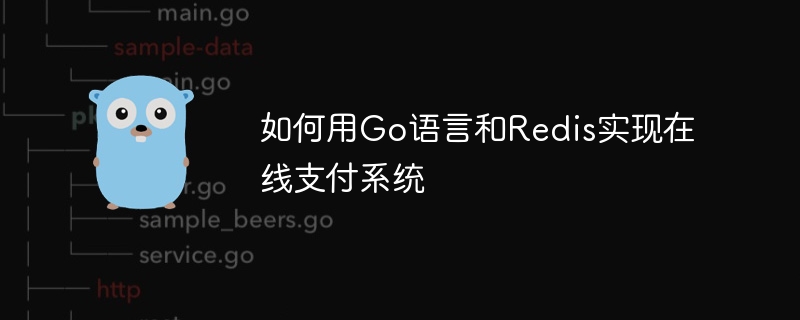如何用Go语言和Redis实现在线支付系统

如何用Go语言和Redis实现在线支付系统
引言:
随着电子商务的迅速发展,越来越多的人们选择在线支付来完成各种交易。而作为在线支付系统的核心重要组件之一,支付系统必须具备高效、安全、可靠的特性。本文将介绍如何使用Go语言和Redis来实现一个简单的在线支付系统,并提供具体的代码示例。
一、系统架构设计
在开始实现之前,我们需要先设计系统的架构。一个基本的在线支付系统通常包括以下组件:
- 用户:系统的支付参与者,拥有账户和资金。
- 商家:系统的交易参与者,可以接收支付请求,完成交易。
- 支付网关:负责接收用户的支付请求,调用支付接口完成支付交易。
- 资金账户:保存用户和商家的资金信息,记录资金的流动情况。
- 交易记录:保存交易的相关信息,以便后续查询和统计。
二、数据库设计
在本系统中,我们使用Redis作为主要的数据库服务,用于存储用户、商家、资金账户和交易记录的信息。
下面是各个数据结构的设计:
- 用户信息(hash结构):
key: user:userid
field: username, password, balance - 商家信息(hash结构):
key: merchant:merchantid
field: merchantname, password - 资金账户信息(hash结构):
key: account:accountid
field: userid, merchantid, balance - 交易记录(list结构):
key: transactions
value: json格式的交易信息
三、代码实现
以下是使用Go语言和Redis实现在线支付系统的示例代码:
-
用户注册
func registerUser(username, password string) error { // 生成唯一的userid userid := generateUserID() // 检查用户名是否已存在 if exists("user:" + username) { return fmt.Errorf("Username already exists") } // 创建用户信息 user := make(map[string]interface{}) user["username"] = username user["password"] = password user["balance"] = 0 // 保存用户信息到Redis setJSON("user:"+userid, user) return nil }登录后复制 商家注册
func registerMerchant(merchantname, password string) error { // 生成唯一的merchantid merchantid := generateMerchantID() // 检查商家名是否已存在 if exists("merchant:" + merchantname) { return fmt.Errorf("Merchant name already exists") } // 创建商家信息 merchant := make(map[string]interface{}) merchant["merchantname"] = merchantname merchant["password"] = password // 保存商家信息到Redis setJSON("merchant:"+merchantid, merchant) return nil }登录后复制创建支付订单
func createPaymentOrder(userid, merchantid string, amount float64) error { // 检查用户是否存在 if !exists("user:" + userid) { return fmt.Errorf("User not found") } // 检查商家是否存在 if !exists("merchant:" + merchantid) { return fmt.Errorf("Merchant not found") } // 检查用户余额是否足够 if getBalance("user:"+userid) < amount { return fmt.Errorf("Insufficient balance") } // 生成唯一的orderid orderid := generateOrderID() // 创建订单信息 order := make(map[string]interface{}) order["userid"] = userid order["merchantid"] = merchantid order["amount"] = amount order["status"] = "Created" // 保存订单信息到Redis setJSON("order:"+orderid, order) return nil }登录后复制支付订单
func confirmPayment(orderid, password string) error { // 检查订单是否存在 if !exists("order:" + orderid) { return fmt.Errorf("Order not found") } // 获取订单信息 order := getJSON("order:" + orderid).(map[string]interface{}) // 检查订单状态是否正确 if order["status"] != "Created" { return fmt.Errorf("Invalid order status") } // 检查商家密码是否正确 merchant := getJSON("merchant:" + order["merchantid"].(string)).(map[string]interface{}) if merchant["password"] != password { return fmt.Errorf("Invalid merchant password") } // 扣除用户余额 balance := getBalance("user:" + order["userid"].(string)) balance -= order["amount"].(float64) setBalance("user:"+order["userid"].(string), balance) // 增加商家余额 balance = getBalance("merchant:" + order["merchantid"].(string)) balance += order["amount"].(float64) setBalance("merchant:"+order["merchantid"].(string), balance) // 更新订单状态 order["status"] = "Paid" setJSON("order:"+orderid, order) // 创建交易记录 transaction := make(map[string]interface{}) transaction["orderid"] = orderid transaction["userid"] = order["userid"].(string) transaction["merchantid"] = order["merchantid"].(string) transaction["amount"] = order["amount"].(float64) pushJSON("transactions", transaction) return nil }登录后复制
四、总结
本文介绍了如何使用Go语言和Redis来实现一个简单的在线支付系统。通过合理设计系统架构、灵活使用Redis的数据结构和命令,我们可以方便地管理用户、商家、资金账户和交易记录的信息,并实现支付功能。当然,实际的在线支付系统还需要考虑更多的安全性、性能和可扩展性的问题,但是本文提供的代码示例可以作为一个很好的起点,供读者参考和学习。
参考文献:
[1] Go语言官方文档:https://golang.org/
[2] Redis官方文档:https://redis.io/
以上是如何用Go语言和Redis实现在线支付系统的详细内容。更多信息请关注PHP中文网其他相关文章!

热AI工具

Undresser.AI Undress
人工智能驱动的应用程序,用于创建逼真的裸体照片

AI Clothes Remover
用于从照片中去除衣服的在线人工智能工具。

Undress AI Tool
免费脱衣服图片

Clothoff.io
AI脱衣机

AI Hentai Generator
免费生成ai无尽的。

热门文章

热工具

记事本++7.3.1
好用且免费的代码编辑器

SublimeText3汉化版
中文版,非常好用

禅工作室 13.0.1
功能强大的PHP集成开发环境

Dreamweaver CS6
视觉化网页开发工具

SublimeText3 Mac版
神级代码编辑软件(SublimeText3)

热门话题
 redis集群模式怎么搭建
Apr 10, 2025 pm 10:15 PM
redis集群模式怎么搭建
Apr 10, 2025 pm 10:15 PM
Redis集群模式通过分片将Redis实例部署到多个服务器,提高可扩展性和可用性。搭建步骤如下:创建奇数个Redis实例,端口不同;创建3个sentinel实例,监控Redis实例并进行故障转移;配置sentinel配置文件,添加监控Redis实例信息和故障转移设置;配置Redis实例配置文件,启用集群模式并指定集群信息文件路径;创建nodes.conf文件,包含各Redis实例的信息;启动集群,执行create命令创建集群并指定副本数量;登录集群执行CLUSTER INFO命令验证集群状态;使
 redis指令怎么用
Apr 10, 2025 pm 08:45 PM
redis指令怎么用
Apr 10, 2025 pm 08:45 PM
使用 Redis 指令需要以下步骤:打开 Redis 客户端。输入指令(动词 键 值)。提供所需参数(因指令而异)。按 Enter 执行指令。Redis 返回响应,指示操作结果(通常为 OK 或 -ERR)。
 redis数据怎么清空
Apr 10, 2025 pm 10:06 PM
redis数据怎么清空
Apr 10, 2025 pm 10:06 PM
如何清空 Redis 数据:使用 FLUSHALL 命令清除所有键值。使用 FLUSHDB 命令清除当前选定数据库的键值。使用 SELECT 切换数据库,再使用 FLUSHDB 清除多个数据库。使用 DEL 命令删除特定键。使用 redis-cli 工具清空数据。
 redis怎么读源码
Apr 10, 2025 pm 08:27 PM
redis怎么读源码
Apr 10, 2025 pm 08:27 PM
理解 Redis 源码的最佳方法是逐步进行:熟悉 Redis 基础知识。选择一个特定的模块或功能作为起点。从模块或功能的入口点开始,逐行查看代码。通过函数调用链查看代码。熟悉 Redis 使用的底层数据结构。识别 Redis 使用的算法。
 redis怎么使用单线程
Apr 10, 2025 pm 07:12 PM
redis怎么使用单线程
Apr 10, 2025 pm 07:12 PM
Redis 使用单线程架构,以提供高性能、简单性和一致性。它利用 I/O 多路复用、事件循环、非阻塞 I/O 和共享内存来提高并发性,但同时存在并发性受限、单点故障和不适合写密集型工作负载的局限性。
 redis怎么读取队列
Apr 10, 2025 pm 10:12 PM
redis怎么读取队列
Apr 10, 2025 pm 10:12 PM
要从 Redis 读取队列,需要获取队列名称、使用 LPOP 命令读取元素,并处理空队列。具体步骤如下:获取队列名称:以 "queue:" 前缀命名,如 "queue:my-queue"。使用 LPOP 命令:从队列头部弹出元素并返回其值,如 LPOP queue:my-queue。处理空队列:如果队列为空,LPOP 返回 nil,可先检查队列是否存在再读取元素。
 redis怎么查看所有的key
Apr 10, 2025 pm 07:15 PM
redis怎么查看所有的key
Apr 10, 2025 pm 07:15 PM
要查看 Redis 中的所有键,共有三种方法:使用 KEYS 命令返回所有匹配指定模式的键;使用 SCAN 命令迭代键并返回一组键;使用 INFO 命令获取键的总数。
 redis底层怎么实现
Apr 10, 2025 pm 07:21 PM
redis底层怎么实现
Apr 10, 2025 pm 07:21 PM
Redis 使用哈希表存储数据,支持字符串、列表、哈希表、集合和有序集合等数据结构。Redis 通过快照 (RDB) 和追加只写 (AOF) 机制持久化数据。Redis 使用主从复制来提高数据可用性。Redis 使用单线程事件循环处理连接和命令,保证数据原子性和一致性。Redis 为键设置过期时间,并使用 lazy 删除机制删除过期键。






